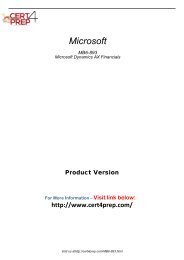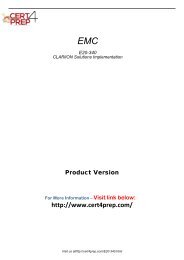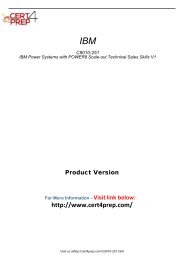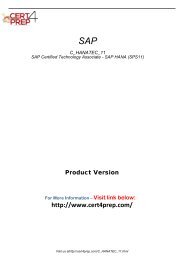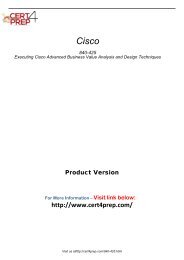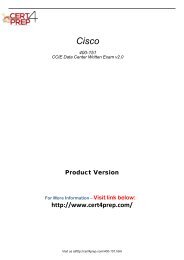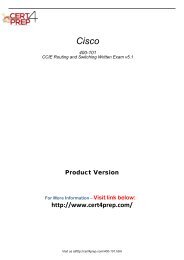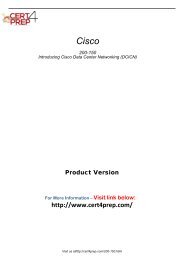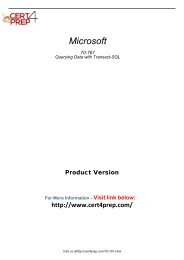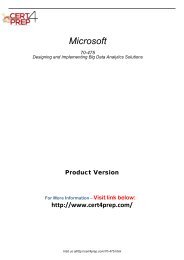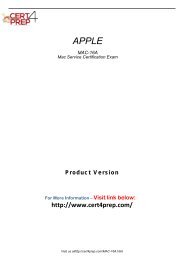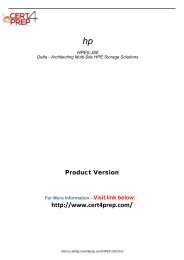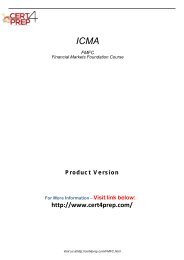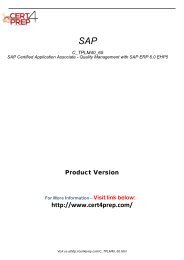70-697 Practice Exam
Our workable study material for 70-697 Exam meets the exact and accurate exam questions and answers. So that’s why Cert4Prep is popular in the field of IT Certification Exams material providers. For more information about exam please visit here: http://www.cert4prep.com/70-697.html
Our workable study material for 70-697 Exam meets the exact and accurate exam questions and answers. So that’s why Cert4Prep is popular in the field of IT Certification Exams material providers. For more information about exam please visit here: http://www.cert4prep.com/70-697.html
Create successful ePaper yourself
Turn your PDF publications into a flip-book with our unique Google optimized e-Paper software.
Microsoft<br />
<strong>70</strong>-<strong>697</strong><br />
Configuring Windows Devices<br />
Product Version<br />
For More Information – Visit link below:<br />
http://www.cert4prep.com/<br />
Visit us athttp://cert4prep.com/<strong>70</strong>-<strong>697</strong>.html
Question: 1<br />
You support Windows 10 Enterprise computers that are members of an Active Directory domain. Your<br />
company policy defines the list of approved Windows Store apps that are allowed for download and<br />
installation.<br />
You have created a new AppLocker Packaged Apps policy to help enforce the company policy.<br />
You need to test the new AppLocker Packaged Apps policy before you implement it for the entire<br />
company.<br />
What should you do?<br />
A. From Group Policy, enforce the new AppLocker policy in Audit Only mode.<br />
B. From Group Policy, run the Group Policy Results Wizard.<br />
C. From Group Policy, run the Group Policy Modeling Wizard.<br />
D. From PowerShell, run the Get-AppLocker Policy –Effective command to retrieve the AppLocker<br />
effective policy.<br />
Answer: A<br />
Explanation:<br />
You can test an AppLocker Packaged Apps policy by running it in audit mode.<br />
After AppLocker rules are created within the rule collection, you can configure the enforcement setting<br />
to Enforce rules or Audit only.<br />
When AppLocker policy enforcement is set to Enforce rules, rules are enforced for the rule collection<br />
and all events are audited. When AppLocker policy enforcement is set to Audit only, rules are only<br />
evaluated but all events generated from that evaluation are written to the AppLocker log.<br />
Question: 2<br />
You support Windows 10 Enterprise computers.<br />
Your company has started testing Application Virtualization (App-V) applications on several laptops. You<br />
discover that the App-V applications are available to users even when the laptops are offline.<br />
You need to ensure that the App-V applications are available to users only when they are connected to<br />
the company network.<br />
What should you do?<br />
A. Change user permissions to the App-V applications.<br />
B. Disable the Disconnected operation mode.<br />
C. Configure mandatory profiles for laptop users.<br />
D. Reset the App-V client File System cache.<br />
Explanation:<br />
Answer: B<br />
Visit us athttp://cert4prep.com/<strong>70</strong>-<strong>697</strong>.html
Disconnected operation mode is enabled by default and allows App-V applications to be available to<br />
users even when the laptops are offline. We need to disable Disconnected operation mode to prevent<br />
offline access.<br />
The disconnected operation mode settings—accessible by right-clicking the Application Virtualization<br />
node, selecting Properties, and clicking the Connectivity tab—enables the Application Virtualization<br />
Desktop Client or Client for Remote Desktop Services (formerly Terminal Services) to run applications<br />
that are stored in the file system cache of the client when the client is unable to connect to the<br />
Application Virtualization Management Server.<br />
Question: 3<br />
HOTSPOT<br />
You have an image of Windows 10 Enterprise named Image1. Image1 has version number 1.0.0.0 of a<br />
custom, line-of-business universal app named App1.<br />
You deploy Image1 to Computer1 for a user named User1.<br />
You need to update App1 to version 1.0.0.1 on Computer1 for User1 only.<br />
What command should you run? To answer, select the appropriate options in the answer area.<br />
Answer:<br />
Explanation:<br />
In this question, we need to update App1 toversion1.0.0.1 on Computer1 “for User1 only”. The Add-<br />
AppxPackage cmdlet adds a signed app package (.appx) to a user account.<br />
To update the application, we need to use the –path parameter to specify the path to the upgraded<br />
application.<br />
Visit us athttp://cert4prep.com/<strong>70</strong>-<strong>697</strong>.html
Question: 4<br />
DRAG DROP<br />
You manage Microsoft Intune for a company named Contoso. You have an administrative computer<br />
named Computer1 that runs Windows 10 Enterprise.<br />
You need to add a Windows Store universal app named App1 to the Company Portal Apps list for all<br />
users.<br />
Which three actions should you perform in sequence? To answer, move the appropriate actions from<br />
the list of actions to the answer area and arrange them in the correct order.<br />
Answer:<br />
Question: 5<br />
Your network contains an Active Directory domain named contoso.com. The domain contains Windows<br />
10 Enterprise client computers.<br />
Your company has a subscription to Microsoft Office 365. Each user has a mailbox that is stored in Office<br />
365 and a user account in the contoso.com domain. Each mailbox has two email addresses.<br />
You need to add a third email address for each user.<br />
What should you do?<br />
Visit us athttp://cert4prep.com/<strong>70</strong>-<strong>697</strong>.html
A. From Active Directory Users and Computers, modify the E-mail attribute for each user.<br />
B. From Microsoft Azure Active Directory Module for Windows PowerShell, run the Set-Mailbox cmdlet.<br />
C. From Active Directory Domains and Trust, add a UPN suffix for each user.<br />
D. From the Office 365 portal, modify the Users settings of each user.<br />
Answer: B<br />
Explanation:<br />
We can use the Set-Mailbox cmdlet to modify the settings of existing mailboxes.<br />
The EmailAddresses parameter specifies all the email addresses (proxy addresses) for the recipient,<br />
including the primary SMTP address. In on-premises Exchange organizations, the primary SMTP address<br />
and other proxy addresses are typically set by email address policies. However, you can use this<br />
parameter to configure other proxy addresses for the recipient.<br />
To add or remove specify proxy addresses without affecting other existing values, use the following<br />
syntax:<br />
@{Add="[]:","[]:"...;<br />
Remove="[]:","[]:"...}.<br />
Question: 6<br />
HOTSPOT<br />
You manage a Microsoft Azure RemoteApp deployment. The deployment consists of a cloud collection<br />
named CloudCollection1 and a hybrid collection named HybridCollection1. Both collections reside in a<br />
subscription named Subscription1. Subscription1 contains two Active Directory instances named<br />
AzureAD1 and AzureAD2. AzureAD1 is the associated directory of Subcsription1.<br />
AzureAD1 is synchronized to an on-premises Active Directory forest named constoso.com. Passwords<br />
are synchronized between AzureAD1 and the on-premises Active Directory.<br />
You have the following user accounts:<br />
You need to identify to which collections each user can be assigned access.<br />
What should you identify? To answer, select the appropriate options in the answer area.<br />
Visit us athttp://cert4prep.com/<strong>70</strong>-<strong>697</strong>.html
Visit us athttp://cert4prep.com/<strong>70</strong>-<strong>697</strong>.html<br />
Answer:
Explanation:<br />
A Microsoft account can only access a cloud collection.<br />
An Azure Active Directory (Azure AD) account can access a cloud collection and it can access a hybrid<br />
collection if directory synchronization with password sync is deployed.<br />
An on-premise domain account that does not exist in any Azure Active Directory cannot access Azure<br />
cloud resources.<br />
References:<br />
https://azure.microsoft.com/en-gb/documentation/articles/remoteapp-collections/<br />
Question: 7<br />
Your Windows 10 Enterprise work computer is a member of an Active Directory domain. You use your<br />
domain account to log on to the computer. You use your Microsoft account to log on to a home laptop.<br />
You want to access Windows 10 Enterprise apps from your work computer by using your Microsoft<br />
account.<br />
You need to ensure that you are able to access the Windows 10 Enterprise apps on your work computer<br />
by logging on only once.<br />
What should you do?<br />
A. Add the Microsoft account as a user on your work computer.<br />
B. Enable Remote Assistance on your home laptop.<br />
C. Connect your Microsoft account to your domain account on your work computer.<br />
D. Install SkyDrive for Windows on both your home laptop and your work computer.<br />
Answer: C<br />
Explanation:<br />
You can connect your Microsoft account to your domain account on your work computer. This will<br />
enable you to sign in to your work computer with your Microsoft account and access the same resources<br />
that you would access if you were logged in with your domain account.<br />
When you connect your Microsoft account to your domain account, you can sync your settings and<br />
preferences between them. For example, if you use a domain account in the workplace, you can connect<br />
your Microsoft account to it and see the same desktop background, app settings, browser history and<br />
favorites, and other Microsoft account settings that you see on your home PC.<br />
Question: 8<br />
You administer a Windows 10 Enterprise computer that runs Hyper-V. The computer hosts a virtual<br />
machine with multiple snapshots. The virtual machine uses one virtual CPU and 512 MB of RAM.<br />
You discover that the virtual machine pauses automatically and displays the state as paused-critical.<br />
You need to identify the component that is causing the error.<br />
Which component should you identify?<br />
Visit us athttp://cert4prep.com/<strong>70</strong>-<strong>697</strong>.html
A. no virtual switch defined<br />
B. insufficient memory<br />
C. insufficient hard disk space<br />
D. insufficient number of virtual processors<br />
Answer: C<br />
Explanation:<br />
In this question, the VM has “multiple snapshots” which would use up a lot of disk space. Virtual<br />
machines will go into the “Paused-Critical” state in Hyper-V if the free space on the drive that contains<br />
the snapshots goes below 200MB.<br />
One thing that often trips people up is if they have their virtual hard disks configured on one drive – but<br />
have left their snapshot files stored on the system drive. Once a virtual machine snapshot has been<br />
taken– the base virtual hard disk stops expanding and the snapshot file stores new data that is written<br />
to the disk – so it is critical that there is enough space in the snapshot storage location.<br />
Question: 9<br />
You have a Windows 10 Enterprise computer named Computer1 that has the Hyper-V feature installed.<br />
Computer1 hosts a virtual machine named VM1. VM1 runs Windows 10 Enterprise. VM1 connects to a<br />
private virtual network switch.<br />
From Computer1, you need to remotely execute Windows PowerShell cmdlets on VM1.<br />
What should you do?<br />
A. Run the winrm.exe command and specify the –s parameter.<br />
B. Run the Powershell.exe command and specify the –Command parameter.<br />
C. Run the Receive-PSSession cmdlet and specify the –Name parameter.<br />
D. Run the Invoke-Command cmdlet and specify the –VMName parameter.<br />
Answer: D<br />
Explanation:<br />
We can use Windows PowerShell Direct to run PowerShell cmdlets on a virtual machine from the Hyper-<br />
V host. Because Windows PowerShell Direct runs between the host and virtual machine, there is no<br />
need for a network connection or to enable remote management.<br />
There are no network or firewall requirements or special configuration. It works regardless of your<br />
remote management configuration. To use it, you must run Windows 10 or Windows Server Technical<br />
Preview on the host and the virtual machine guest operating system.<br />
To create a PowerShell Direct session, use one of the following commands:<br />
Enter-PSSession -VMName VMName<br />
Invoke-Command -VMName VMName -ScriptBlock {commands}<br />
Question: 10<br />
Visit us athttp://cert4prep.com/<strong>70</strong>-<strong>697</strong>.html
You deploy several tablet PCs that run Windows 10 Enterprise.<br />
You need to minimize power usage when the user presses the sleep button.<br />
What should you do?<br />
A. In Power Options, configure the sleep button setting to Sleep.<br />
B. In Power Options, configure the sleep button setting to Hibernate.<br />
C. Configure the active power plan to set the system cooling policy to passive.<br />
D. Disable the C-State control in the computer’s BIOS.<br />
Answer: B<br />
Explanation:<br />
We can minimize power usage on the tablet PCs by configuring them to use Hibernation mode. A<br />
computer in hibernation mode uses no power at all.<br />
Hibernation is a power-saving state designed primarily for laptops. While sleep puts your work and<br />
settings in memory and draws a small amount of power, hibernation puts your open documents and<br />
programs on your hard disk, and then turns off your computer. Of all the power-saving states in<br />
Windows, hibernation uses the least amount of power. On a laptop, use hibernation when you know<br />
that you won't use your laptop for an extended period and won't have an opportunity to charge the<br />
battery during that time.<br />
Question: 11<br />
You are the desktop administrator for a small company.<br />
Your workgroup environment consists of Windows 10 Enterprise computers. You want to prevent 10<br />
help desk computers from sleeping. However, you want the screens to shut off after a certain period of<br />
time if the computers are not being used.<br />
You need to configure and apply a standard power configuration scheme for the 10 help desk computers<br />
on your network.<br />
Which two actions should you perform? Each correct answer presents part of the solution.<br />
A. Import the power scheme by using POWERCFG /IMPORT on each of the remaining help desk<br />
computers. Set the power scheme to Active by using POWERCFG /S.<br />
B. Use POWERCFG /X on one help desk computer to modify the power scheme to meet the<br />
requirements. Export the power scheme by using POWERCFG /EXPORT.<br />
C. Use POWERCFG /S on one help desk computer to modify the power scheme to meet the<br />
requirements. Export the power scheme by using POWERCFG /EXPORT.<br />
D. Import the power scheme by using POWERCFG /IMPORT on each of the remaining help desk<br />
computers. Set the power scheme to Active by using POWERCFG /X.<br />
Answer: A,B<br />
Explanation:<br />
You can use the Powercfg.exe tool to control power settings and configure computers to default to<br />
Hibernate or Standby modes.<br />
Visit us athttp://cert4prep.com/<strong>70</strong>-<strong>697</strong>.html
In this question, we use POWERCFG /X on one help desk computer to modify the power scheme to meet<br />
our requirements. After configuring the required settings, we can export the power scheme settings to a<br />
file by using POWERCFG /EXPORT.<br />
We can then import the power scheme from the file on each of the remaining help desk computers by<br />
using POWERCFG /IMPORT. After importing the power scheme on the remaining computers, we need to<br />
set the new power scheme to be the active power scheme by using POWERCFG /S.<br />
Question: 12<br />
A company has an Active Directory Domain Services (AD DS) domain. All client computers run Windows<br />
10 Enterprise. Some computers have a Trusted Platform Module (TPM) chip.<br />
You need to configure a single Group Policy object (GPO) that will allow Windows BitLocker Drive<br />
Encryption on all client computers.<br />
Which two actions should you perform? Each correct answer presents part of the solution.<br />
A. Enable the Require additional authentication at startup policy setting.<br />
B. Enable the Enforce drive encryption type on operating system drives policy setting.<br />
C. Enable the option to allow BitLocker without a compatible TPM.<br />
D. Configure the TPM validation profile to enable Platform Configuration Register indices (PCRs) 0, 2, 4,<br />
and 11.<br />
Answer: A,C<br />
Explanation:<br />
We need to allow Windows BitLocker Drive Encryption on all client computers (including client<br />
computers that do not have Trusted Platform Module (TPM) chip).<br />
We can do this by enabling the option to allow BitLocker without a compatible TPM in the group policy.<br />
The ‘Allow BitLocker without a compatible TPM’ option is a checkbox in the ‘Require additional<br />
authentication at startup’ group policy setting. To access the ‘Allow BitLocker without a compatible<br />
TPM’ checkbox, you need to first select Enabled on the ‘Require additional authentication at startup’<br />
policy setting.<br />
Question: 13<br />
Employees are permitted to bring personally owned portable Windows 10 Enterprise computers to the<br />
office. They are permitted to install corporate applications by using the management infrastructure<br />
agent and access corporate email by using the Mail app.<br />
An employee’s personally owned portable computer is stolen.<br />
You need to protect the corporate applications and email messages on the computer.<br />
Which two actions should you perform? Each correct answer presents part of the solution.<br />
A. Prevent the computer from connecting to the corporate wireless network.<br />
B. Change the user’s password.<br />
C. Disconnect the computer from the management infrastructure.<br />
Visit us athttp://cert4prep.com/<strong>70</strong>-<strong>697</strong>.html
D. Initiate a remote wipe.<br />
Answer: B,D<br />
Explanation:<br />
The personally owned portable Windows10Enterprise computers being managed by the management<br />
infrastructure agent enables the use of remote wipe. By initiating a remote wipe, we can erase all<br />
company data including email from the stolen device.<br />
Microsoft Intune provides selective wipe, full wipe, remote lock, and passcode reset capabilities.<br />
Because mobile devices can store sensitive corporate data and provide access to many corporate<br />
resources, you can issue a remote device wipe command from the Microsoft Intune administrator<br />
console to wipe a lost or stolen device.<br />
Changing the user’s password should be the first step. If the stolen computer is accessed before the<br />
remote wipe happens, the malicious user could be able to access company resources if the laptop has<br />
saved passwords.<br />
Question: 14<br />
You are an IT consultant for small and mid-sized business.<br />
One of your clients wants to start using Virtual Smart Cards on its Windows 10 Enterprise laptops and<br />
tablets. Before implementing any changes, the client wants to ensure that the laptops and tablets<br />
support Virtual Smart Cards.<br />
You need to verify that the client laptops and tablets support Virtual Smart Cards.<br />
What should you do?<br />
A. Ensure that each laptop and tablet has a Trusted Platform Module (TPM) chip of version 1.2 or<br />
greater.<br />
B. Ensure that BitLocker Drive Encryption is enabled on a system drive of the laptops and tablets.<br />
C. Ensure that each laptop and tablet can read a physical smart card.<br />
D. Ensure that the laptops and tablets are running Windows 10 Enterprise edition.<br />
Answer: A<br />
Explanation:<br />
A Trusted Platform Module (TPM) chip of version 1.2 or greater is required to support Virtual Smart<br />
Cards.<br />
Virtual smart card technology from Microsoft offers comparable security benefits to physical smart<br />
cards by using two-factor authentication. Virtual smart cards emulate the functionality of physical smart<br />
cards, but they use the Trusted Platform Module (TPM) chip that is available on computers in many<br />
organizations, rather than requiring the use of a separate physical smart card and reader. Virtual smart<br />
cards are created in the TPM, where the keys that are used for authentication are stored in<br />
cryptographically secured hardware.<br />
Question: 15<br />
Visit us athttp://cert4prep.com/<strong>70</strong>-<strong>697</strong>.html
Your network contains an Active Directory domain named contoso.com. Contoso.com is synchronized to<br />
a Microsoft Azure Active Directory. You have a Microsoft Intune subscription.<br />
Your company plans to implement a Bring Your Own Device (BYOD) policy. You will provide users with<br />
access to corporate data from their personal iOS devices.<br />
You need to ensure that you can manage the personal iOS devices.<br />
What should you do first?<br />
A. Install the Company Portal app from the Apple App Store.<br />
B. Create a device enrollment manager account.<br />
C. Set a DNS alias for the enrollment server address.<br />
D. Configure the Intune Service to Service Connector for Hosted Exchange.<br />
E. Enroll for an Apple Push Notification (APN) certificate.<br />
Answer: E<br />
Explanation:<br />
An Apple Push Notification service (APNs) certificate must first be imported from Apple so that you can<br />
manage iOS devices. The certificate allows Intune to manage iOS devices and institutes an accredited<br />
and encrypted IP connection with the mobile device management authority services.<br />
Visit us athttp://cert4prep.com/<strong>70</strong>-<strong>697</strong>.html
Powered by TCPDF (www.tcpdf.org)<br />
For More Information – Visit link below:<br />
http://www.cert4prep.com/<br />
Thanks for Using Our Product:<br />
FEATURES:<br />
‣ 100% Pass Guarantee<br />
‣ 30 DaysMoney Back Guarantee<br />
‣ 24/7 Live Chat Support(Technical & Sales)<br />
‣ Instant Download or Email Attachment<br />
‣ 50,000 +ve Reviews<br />
‣ 100% Success Rate<br />
‣ Discounts Available for Bulk Orders<br />
We Accept<br />
Visit us athttp://cert4prep.com/<strong>70</strong>-<strong>697</strong>.html



